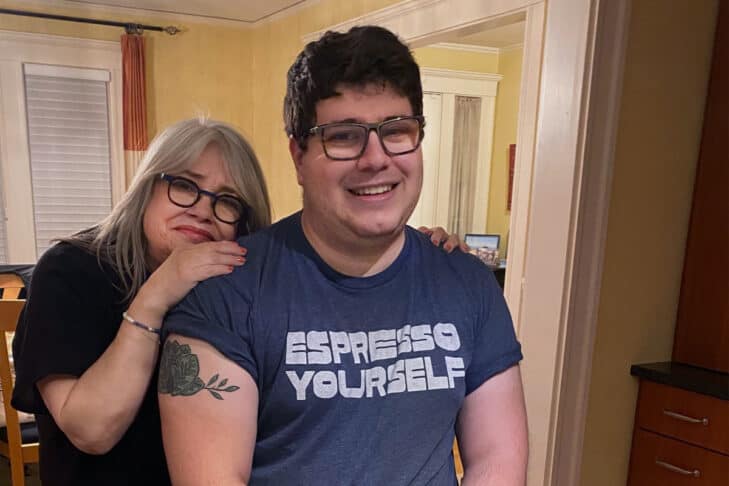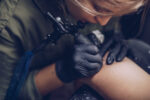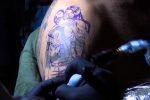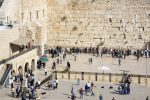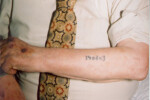When my son, Adam, and I went out to lunch last fall, he asked a question that stunned me: Was there anything he could do that would make his father and me stop loving him? “Never,” I said. “We adore you.” Then he blurted out news he thought might disturb our mother-son cocoon: “I have an appointment to get a tattoo.”
Adam is the first person in our family to tattoo his body. He is 25 years old, a medical student and a queer man who has not always been comfortable in his body. He came out to his father and me on a Saturday morning in the kitchen when he was 16.
His was a rushed yet pointed declaration: “I am gay.” Before we could react, he hurried away, and we worried that he thought he had upset us. “Come back,” my husband, Ken, and I said. “We love you forever.” The three of us then fell into a tight group hug. We told Adam he would always be ours—loved unconditionally. And then in the sweet, blessed paradox that is the essence of parenting, we sent him on his way to live life on his own terms.
The tattoo, as green as the mountains of Vermont where Adam lives, is a peacock whose feathers bear the leaves of a calathea plant. It blooms on his upper right arm. While the scrubs he wears at work almost cover it, that is not the goal. “The white coat comes with certain expectations,” Adam says. “So many people have tattoos. It’s reassuring to my patients to see themselves in me, particularly in a health care setting that brings out feelings of vulnerability.”
Adam told me he had been dreaming of getting a tattoo since high school. He and his sister, Anna, gave each other calathea plants last summer before leaving for their respective schools. He was headed north; she was headed west. The idea was that until they met again in person, they would have the plants for succor.
But Adam always wanted to have the plant’s spirit with him, and he knew he’d have it permanently inked on his arm. The calathea is known as the “prayer” plant, so called because it changes positions during the day. At night the plant perks up a bit, and its leaves come together in private supplication.
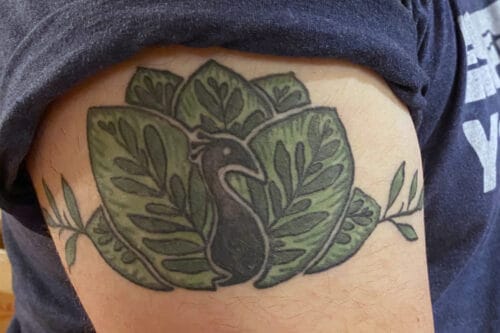
The plant is also playfully called the “peacock calathea.” Adam has loved peacocks since he was a little boy. When he went to school on New York’s Upper West Side, he visited the peacocks in residence on the grounds of the Cathedral of St. John the Divine, where they impressively fanned out their feathers in pure ornamentation. Those feathers seemingly have no use until you reach back into Jewish tradition and dust off the commandment that one’s surroundings must be beautiful.
Hiddur mitzvah—beautifying one’s world—extends to beautifying one’s life. My son has made the concept and the commandment his own. He beautifies the world with his empathy, his strength, his wisdom. At just 25, he has held hands with the very sick, visited babies on his own time in the neonatal nursery and saved lives when he was an EMT in college.
Adam had an appointment to get inked long before he told me. He assured me the tattooist was a talented artist. He was also quick to dispense with the myth that a tattooed body cannot be buried in a Jewish cemetery. In another era, the rationale was that our bodies do not belong to us, and we cannot defile them. “My tattoo is not a desecration of anything,” he said. “It’s a beautiful design with deep significance to me. How is that drifting away from God’s message?”
It is not. A higher being inspired my son to reclaim his body and celebrate his queerness. Adam’s tattoo is an essential example of that reclamation and of a personal Hiddur Mitzvah—beautifying oneself for the peace of acceptance.
In the bold, life-affirming greenery emblazoned on Adam’s upper right arm, the plant’s leaves fan out impressively like the peacocks strutting at St. John the Divine. The tattoo glows so that Adam is glowing too.
I reimagine a version of Ray Bradbury’s “The Illustrated Man” for my family, but with one caveat: When I stare long enough at Adam’s tattoo, I will experience the prayerful calathea leaves wrap themselves around our family—Adam, Anna, Ken and me.


